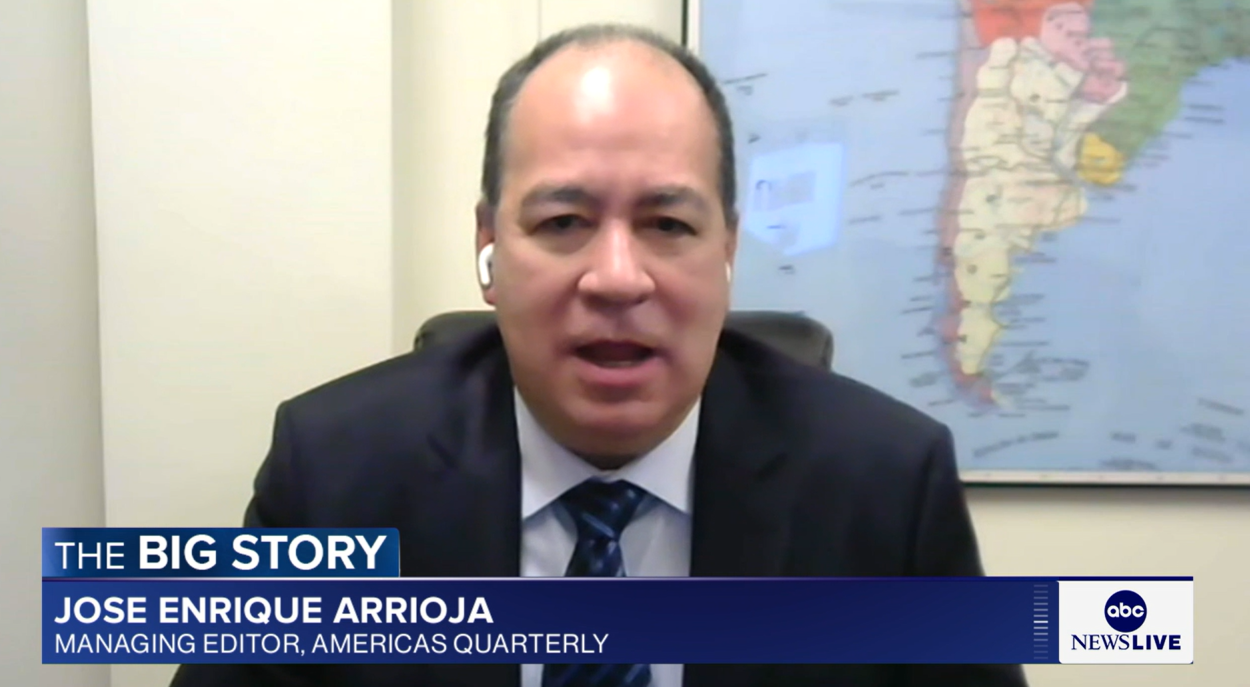The Land of Too Many Summits
The Land of Too Many Summits
The Western Hemisphere could claim the title for summit capital of the world, but events such as the Summit of the Americas repeatedly fall short on accomplishments, writes AS/COA's Christopher Sabatini for ForeignPolicy.com.
With President Barack Obama traveling to Cartagena, Colombia, for the Sixth Summit of the Americas on April 14, observers and journalists are already asking what his administration has done in the region since the last such meeting in Trinidad and Tobago in 2009. It's a good question, but the vague and inconsequential resolutions reached at these summits are a lousy metric to use.
If the number of summits were a measure of the quality of diplomacy, Latin America would be a utopia of harmony, cooperation, and understanding. Indeed, the Western Hemisphere has a strong claim to the title of summit capital of the world with, at last count, more than 16 regional multilateral fora, associations, and organizations. They include the Bolivarian Alternative of the Americas (ALBA), the Latin American Integration Association (ALADI), the Ibero-American Summit, the Union of South American Nations (UNASUR), as well as the old timer on the bloc(k), the oft-maligned Organization of American States (OAS), not to mention its new regional challenger, the Community of Latin American and Caribbean States (CELAC).
Of course, the real business of diplomacy and dealmaking occurs in smaller gatherings of countries or bilaterally between governments that have a genuine unity of purpose and national interests. These smaller meetings -- not the pomp and platitudes from the seemingly unending summit meetings of heads of state jetting around for a photo op -- define the real relations (and interests) in the hemisphere.
Granted, Obama's participation in these summits provides a convenient milestone for examining his administration's Latin America policy. In April 2009, just three months after his inauguration and still in the midst of the global swoon over his election, Obama traveled to the 2009 Fifth Summit of the Americas in Trinidad and Tobago to meet with all the elected heads of state in the region. Now, facing re-election three years later, Obama returns not only to a more economically and diplomatically muscular region but also to the usual whining from regional pundits and journalists that the United States doesn't pay enough attention to it.
That might be a fair charge in general, but the president could be forgiven for not taking gatherings like this weekend's very seriously. The truth is that there are few areas of practical, common interest that align the 34 states participating in the Summit of the Americas other than geographic proximity. The original summit in Miami in 1994 was convened to unite the elected heads of state in the region to discuss two pressing topics: trade and democracy. On the former subject, the goal was to create a hemisphere-wide trade agreement, a dream that faded long ago. And the latter all too often gets sidetracked by distracting skirmishes like Ecuadorean President Rafael Correa's decision this year to boycott the summit because Cuba has not been invited.
The deterioration of American summitry into a platform for easy demagoguery over serious discussion first became evident at the fourth summit, held in Mar del Plata, Argentina, in October 2005. It was there that Venezuelan President Hugo Chávez and then-leader of the Bolivian coca growers union -- and soon to be president -- Evo Morales, with support of the host, then-President Nestor Kirchner, staged an "alternative" summit at a nearby soccer stadium. Alongside soccer legend Diego Maradona, oddly, the group denounced free trade, genetically modified foods, U.S. drug policy, and yanqui imperialism in general.
That these Latin leftist leaders were only an obnoxious minority at the meeting didn't seem to matter. Even though most of the other countries assembled there repeated their commitment to free trade and democracy, it was Chávez's three-ring circus that became the story of the summit. The most fitting punctuation mark to the pomp and populism was when U.S. President George W. Bush jetted off afterward for a working meeting with Brazilian President Luiz Inàcio Lula da Silva, at which the Texas conservative and the leftist former labor leader struck a common chord and agreed to collaborate on a series of initiatives, including reducing barriers to trade.
Regional division -- rather than points of agreement -- was again at the center of discussion at the 2009 Summit in Trinidad and Tobago. In the lead-up to Obama's first major foray into Latin American diplomacy, many hoped that the power of his presence could help heal old wounds. After Obama gave a powerful speech about not re-living past battles and history and about starting a new era of partnership, Chávez sidled up to the U.S. president and gave him a copy of a book by the hoariest of Latin American conspiracy theorists -- Eduardo Galeano, who wrote the classic screed against the developed world's exploitation and the region's victimhood, Open Veins of Latin America, read by every undergraduate student of Latin America in the 1970s and 1980s. Unsurprisingly, that became the story.
Can anyone remember to what the countries committed at the summit or whether they followed through? I follow Latin American politics for a living, and I can't.
Aside from the questionable import of vicinity and the attenuated links of democratically elected governments, are these high-level, broad-scale events really worth the investment in bureaucratic resources, the president's time, and the media's attention? To be sure, by hosting this year's event, President Juan Manuel Santos of Colombia will be able to showcase how far his country has advanced since the civil wars that brought Colombia to the brink of state failure only 20 years ago. But did he need to convene a meeting of 34 heads of state to do that?
When you think of summits in other regions, they all have a certain economic or strategic logic, which lends itself to a more concrete agenda. Whether it's the G-20, the European Union, or APEC, these groups' regular meetings of heads of state discuss economic and diplomatic interests that they can advance, and affect. Precisely because these member countries are united by a common interest and these are seen as serious meetings, the above-mentioned summits would never fall victim to the sort of antics and hollow symbolism that have marked the last two Americas Summits. (Admittedly, there have been the embarrassing moments of heads of state performing unfunny skits at the Association of South East Asian Nation meetings and the thankfully ended custom of appearing in the local garb of the host of the APEC Summit, but those were clearly never the main intent or takeaway, thank God.) Ironically, this year's host has been the country that has best recognized the importance of bilateral bridge-building over pretentious, forced, grip-and-grin multilateral fora. With a newly signed free-trade agreement with the United States and Santos's blizzard of diplomatic trips, bilateral trade deals, and improved relations with neighbors (including Cuba, despite the summit snub), Colombia has become a regional model for how to get things done.
Another example occurred in late March with Obama's meetings with President Felipe Calderón of Mexico and Prime Minister Stephen Harper of Canada, at which the three leaders jointly committed to streamlining regulations to strengthen trade ties, boosting security ties, and supporting entry of Mexico into the U.S.-led negotiations for the Trans-Pacific Partnership (TPP) trade bloc with Australia, Brunei, Chile, New Zealand, Peru, Singapore, and Vietnam. Even the tensions evident in their speeches between President Calderón and Obama over U.S. drug policy and its unwillingness to press for a new assault weapons ban are signs of constructive, mature relations between two countries with a common purpose.
A similar counterpoint occurred earlier this week when Brazilian President Dilma Rousseff traveled to Washington. On the agenda was how the two countries can facilitate commercial investments, expand educational exchanges, and improve energy ties. Given the prickliness of the Brazilian government toward the United States, it was no surprise that no concrete bilateral agreements came out of the discussions. But these points of discussion are far more concrete and actionable than the festive, two-day regional president hug fest that will take place this weekend.
Could the Obama administration have paid more attention to the region in the three years between the summit in Trinidad and Tobago and the one in Cartagena? Sure. But the measure of what it should have done is on the content. The administration should have long ago coordinated regional support for security in Central America, a region being overrun and outgunned by criminal syndicates; it should have accelerated its efforts to create a trans-regional economic bloc to challenge China's encroachment into the hemisphere; and it should already be working intensively with neighboring countries to help ensure free and fair elections in Venezuela, regardless of the outcome.
These are the real issues that matter to the Western Hemisphere's future. But none of them came out of the last summit.
Christopher Sabatini is the Editor-in-Chief of Americas Quarterly, and Senior Director of Policy at Americas Society/Council of the Americas








